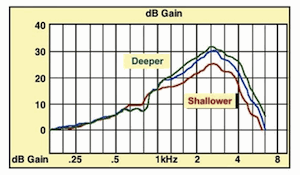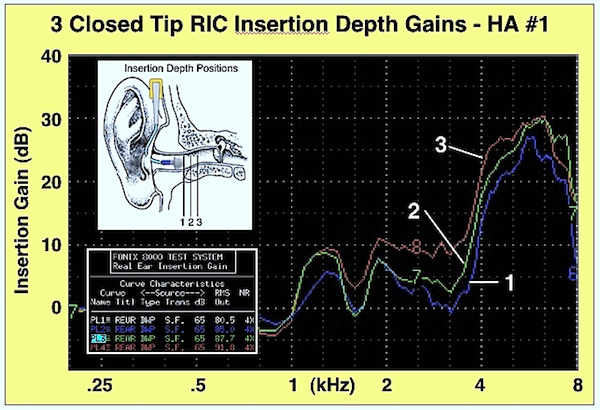Check and Double Check – Closed Fit, Part 1

Figure 1. Closed Tip RIC REAR and insertion tip depth. The data shows that the deeper insertion provides the greatest REAR sound pressures, especially in the high frequencies.
In a previous blog I provided the graph in Figure 1 of an RIC (receiver-in-the-canal) hearing aid fitted with a closed coupler, showing that greater sound pressure resulted, especially in the high frequencies, as the fitting tip was inserted more deeply into the ear canal. These were RIC IG (insertion gain) measurements. This led to a response from Dr. Mead Killion about other effects resulting from various insertion depths when tubing alone was used, and that results would not be expected to follow the same pattern. In support, he provided a graph that showed just the opposite with an open tip fitting.
Dr. Killion suggested that his data be rechecked, which was based on results that he and Don Wilson recorded in 1985. This was a nice gesture on his part, but I felt that if anyone’s data needed rechecking, that it most likely should be my data. That which follows are the results of my retesting. Dr. Killion’s retest data will be presented in the next posting.
Retest
I tested two different hearing aids via real-ear (RIC IG). I no longer had the original response for the hearing aid in Figure 1, so I could not make a direct duplication. These were RIC hearing aids with closed coupling. Additionally, the determination of “insertion depth” is arbitrary, based on subjective feedback from the subject (myself) as to how I think it was seated in the ear. However, here is how I made my insertion depth judgments.
- I set the tip in my ear the way I see many people wearing theirs – knowing that the instrument is not seated properly. This is obvious by the length that the speaker link protrudes from the ear canal, and also that most of the tip can be easily seen. The seal was marginal.
- I set the tip in my ear so that I was certain that there was a seal, but could feel that the tip was not inserted to the proper depth for comfort and security. I “tried” to make this between depths #1 and #3.
- The instrument was seated properly in the ear canal as determined by the speaker link lying flat around and above the tragus, and it was secure as the tip was felt to have passed the second bend.
I could probably guess as to the insertion depths, but am not certain that it is necessary.
Results
The results are posted in Figures 2 and 3. Results appear to agree with the earlier results reported for the closed earmold coupling.

Figure 2. Hearing aid #1. A follow up evaluation of a closed tip RIC hearing instrument, and the effect of three different insertion depths. The deepest insertion depth provided the greatest REAR sound pressures, primarily in the high frequencies.

Figure 3. Hearing aid #2. A followup evaluation of a closed tip RIC hearing instrument, and the effect of three different insertion depths. The deepest insertion depth provided the greatest REAR sound pressures, primarily in the high frequencies.
Next week’s posting will report on the repeat measurements made by Dr. Mead Killion and his colleague Don Wilson, for tubing only type fittings.





